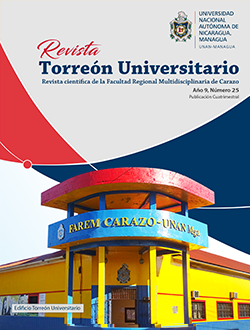Evaluation of the impact of domestic and semi-industrial wastewater on the physical-chemical quality of the Chiquito River, León from May 2016 - January 2017
DOI:
https://doi.org/10.5377/torreon.v9i25.9854Keywords:
water quality, ICP-OES, water quality index, heavy metals, tanneryAbstract
The present study evaluated the impact of wastewater on the physical-chemical quality of two sampling sites, upstream and downstream, in a selected transect of the Chiquito River in the city of León. Samples were taken during four sampling campaigns, two in the rainy season and two in the dry season. Fifteen physical-chemical parameters and twelve metals, metalloids and nonmetals were compared with national (NTON) and international guidelines (U.S. EPA, CCME, NOM, INEN, and FAO). Canadian Software WQI 1.2 was used to comprehensively assess water quality based on a quality index (CWQI), for different uses of water: protection for aquatic life, and irrigation. High levels of contamination excelled by suspended solids, organic matter (oils and fats, BOD and COD, turbidity), nutrients (ammonium, iron) and metals such as Al, Cr3+, Cu, Mn, Se, V, and Zn. The water quality index categorized the site upstream as marginal to regular and poor for downstream, which implies that it was almost always threatened and in most cases departed from desirable levels for the specific uses to which it was submitted. According to CONAGUA, water quality was deteriorated by classifying it from Contaminated to Heavily Contaminated for both sites, with organic matter prevailing implying contamination by discharges of municipal wastewater and tanneries. Hexavalent chromium was detected in May at the upstream site which makes the water in this area more toxic, and the majority of chromium present is in a reduced state.
Downloads
Downloads
Published
How to Cite
Issue
Section
License
Los autores que publican en esta revista están de acuerdo con los siguientes términos.
- El autor o los autores de los artículos, ensayos o investigaciones conceden a la Universidad Nacional Autónoma de Nicaragua, Managua (UNAN-Managua) los derechos de edición (copyright) del trabajo enviado, por consiguiente la Universidad cuenta con el derecho exclusivo para publicar el artículo durante el periodo completo de los derechos de autor.
- Estos derechos de autor/ autores autorizan a la Revista Torreón Universitario y a la Universidad editar y divulgar/publicar el artículo en dicha Revista, incluyendo reproducción impresa y electrónica, el almacenamiento, recuperación y cualquier otro tipo de publicación, y fuentes de información secundaria como servicios de resúmenes y bases de datos, así mismo la facultan a proteger el artículo contra el uso no autorizado para su difusión por medios impresos o electrónicos (PDF, HTML, EPUB, XML u otros).
Licencia para el uso del contenido
La revista hace uso de la Licencia Creative Commons Atribución-NoComercial-SinDerivar 4.0 Internacional.
Bajo esta declaración:

Este revista está sujeta a una licencia de Creative Commons Reconocimiento-NoComercial-SinObraDerivada 4.0 Internacional. Puede ser copiada, distribuida y transmitida públicamente siempre y cuando se cite al autor y la fuente (Revista Torreón Universitario), no debe modificarse ni utilizarse con ningún fin comercial. La licencia completa se puede consultar en http://creativecommons.org/licenses/by-nc-nd/4.0/.

